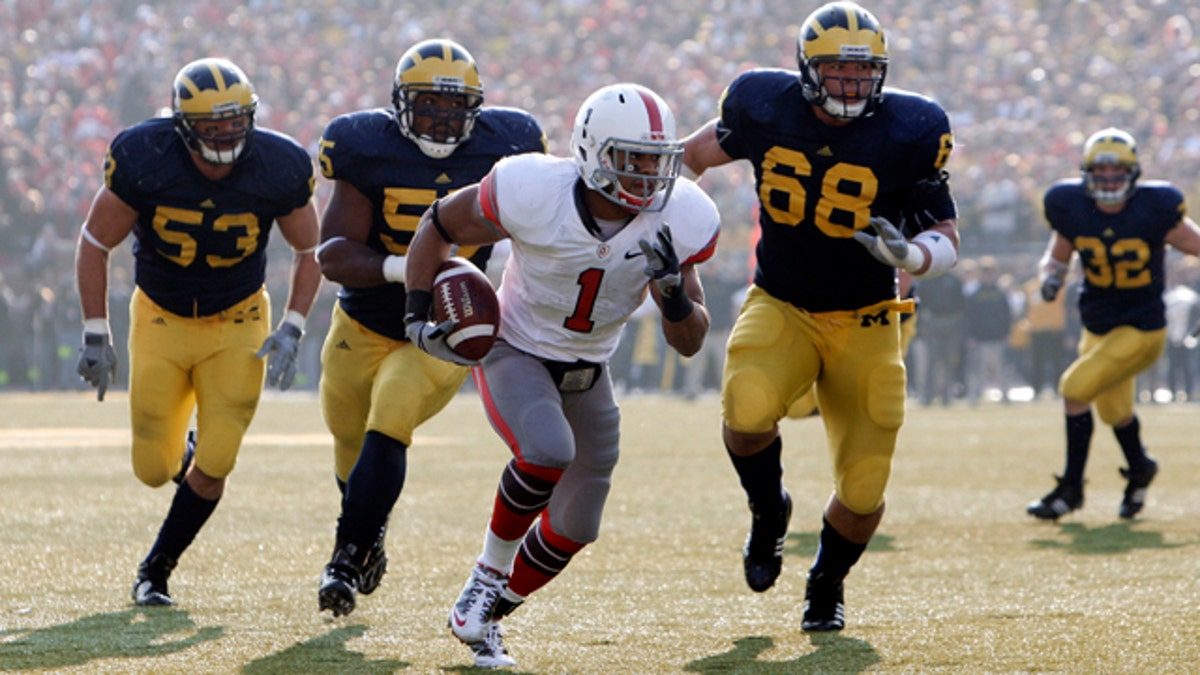
FILE - In this Nov. 21, 2009 file photo, Ohio State running back Dan Herron (1) scores a touchdown on a 12-yard reception as the Michigan defense chases during the third quarter of an NCAA college football game in Ann Arbor, Mich. So you're the Big Ten or Pac-10 and you're trying to decide how to split your new, 12-team league into two divisions while keeping traditional rivalries intact and avoiding competitive imbalance and geographic oddities. The SEC, ACC and Big 12 have been through this before _ and their experiences may offer a few lessons. (AP Photo/Paul Sancya, File) (AP)
The effect that concussions and head injuries have on athletes has been a rising concern in the past few years. But does simply playing a contact sport have lasting repercussions on memory and cognition?
A new study published in the American Academy of Neurology has revealed that impacts to the head during contact sports like football and hockey may lead some athletes to experience a decrease in their abilities to remember things or acquire new information.
“We were interested to see if even if [these athletes] had not identified with having a concussion, maybe it affects some cognition from hitting their head over and over throughout the sports season,” Dr. Thomas McAllister, a professor of neurology at The Geisel School of Medicine at Dartmouth in Lebanon, N.H. and the study’s author, told FoxNews.com.
“In prior studies, we used helmets that monitor the frequency and magnitude of impacts,” McAllister said. “A lot of people have very hard hits that we can record that exceed the threshold at which you should have a concussion – but they don’t have the concussion. So it was reasonable to ask if they’re suffering this cognitive impairment.”
For this study, McAllister and his team monitored two groups of college athletes from three Division 1 schools – 214 athletes in contact sports and 45 athletes in non-contact sports. The contact sport athletes played either football or hockey, while the non-contact athletes played sports such as track, crew or Nordic skiing.
Each athlete took thinking and memory tests before and after their respective sports’ seasons. All of them took the imPACT test – a computer-based screening of attention that is widely used by colleges and sports teams to determine if players who have suffered from concussions are ready to return to play. A subset of the athletes took an even more extensive set of tests that measured concentration, memory and other skills.
In theory, the athletes should show improved results if no damage is happening to their heads.
“What’s important to realize is if I gave you these tests and then repeated them three months later, you’d do better on it because you’ve seen it before,” McAllister said.
Upon initial analysis, the results were positive for the athletes.
“In the pre-season, there were no systematic differences between the two groups,” McAllisters said. “The contact sports and non-contact sports athletes looked similar. And these athletes have been hitting their heads for many years until that point, so there wasn’t a significant deterioration after each season.”
“Then when we tested them again at the end of the season, the two groups looked pretty similar,” McAllister added. “It appeared that hitting your head over and over again did not have a bad effect on memory and attention.”
However, McAllister decided to see if any of the athletes performed significantly worse than expected. Upon further examination, a total of 22 percent of the contact sport athletes performed worse than expected compared to just 4 percent of the non-contact sport athletes.
“It raises the question: Is there a subgroup of contact sport athletes whose learning skills are affected by the end of the season?” McAllister said. “Maybe it’s not bad for everybody but for some people, it really is harmful. Efforts should be directed for determining for whom it is bad and why.”
To further investigate their results, McAllister hopes to perform another study using neural imaging to determine which category each athlete falls into. He also wants to do extended retesting to see how the athletes are faring mentally over the course of several years.
In the meantime, McAllister said the results of the study pose both good news and bad news for football athletes and their fans.
“There’s been a pervasive concern that playing contact sports is uniformly bad for people,” McAllister said. “These study results don’t support that. Some of the attention may be on the one in four or five doing worse. If this is true, then maybe the preventive approach is not to stop the sport but to identify those who are at risk for adverse consequences for it.”
